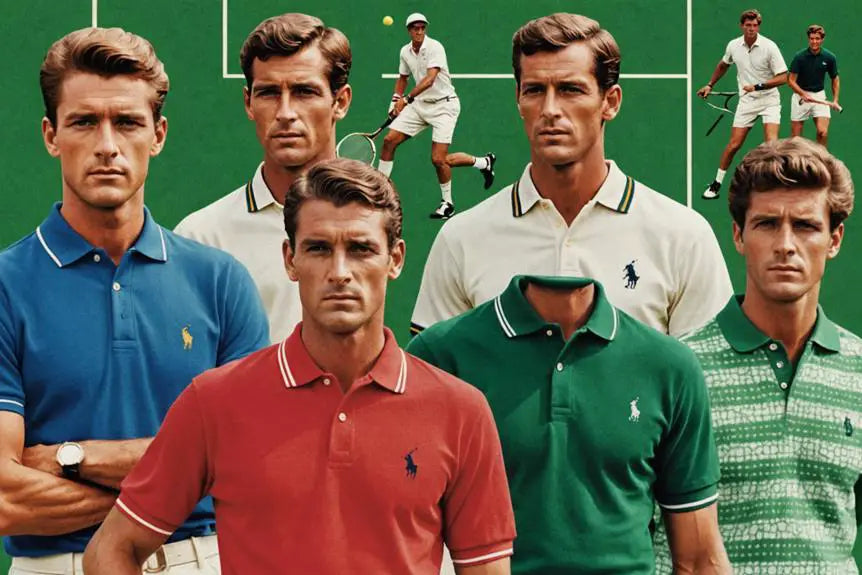
The History of the Polo Shirt
by Natalia Emilse Elbaba on Nov 25, 2024The polo shirt is a timeless wardrobe staple, bridging the gap between casual comfort and smart elegance. Its journey from the playing fields of India to becoming a global fashion icon is as rich as it is fascinating. Let’s explore the history of this classic garment and its enduring influence, especially in the UK. Plus, discover how customised polo shirts have become a modern fashion statement.
Origins: From Polo Fields to Modern Fashion
Roots in Polo and Tennis
The polo shirt’s story begins in the late 19th century with British soldiers stationed in India. They encountered the sport of polo and quickly adopted it, but the traditional attire—a long-sleeved, button-up shirt—was impractical in the heat. To solve this, they introduced a short-sleeved, soft-collared version, known as the “polo shirt.”
The René Lacoste Influence
In the 1920s, French tennis legend René Lacoste revolutionised sportswear by designing a lightweight, breathable shirt for tennis. His version, made from soft cotton piqué, featured a flat collar and short sleeves. Lacoste's innovation laid the foundation for the modern polo shirt, which he popularised under his brand, complete with the iconic crocodile logo.
The British Connection
Polo shirts gained traction in the UK during the 1950s and 1960s. British brands like Fred Perry and Ben Sherman adopted this versatile piece, which soon became a symbol of smart-casual fashion. Its popularity grew among various subcultures, from the Mod movement to the British upper class, who appreciated its blend of sophistication and comfort.
Evolution Through the Decades
The polo shirt has adapted to changing fashion trends while maintaining its core design:
- 1950s-1960s: Adopted by Mods and skinheads, the polo shirt became a symbol of youth rebellion and working-class pride. British bands and icons wore polo shirts, cementing their status as a cultural staple.
- 1970s-1980s: Polo shirts entered mainstream fashion, with luxury brands like Ralph Lauren introducing the garment to a global audience. In the UK, they were embraced by preppy fashion and casual wear enthusiasts.
- 1990s-2000s: Polo shirts became part of the corporate casual dress code. They also featured heavily in the rise of streetwear and sports brands, combining comfort with style.
- Today: Polo shirts remain relevant, with sustainable materials and custom designs gaining popularity. They are seen as both a classic and contemporary piece, suitable for various occasions.
Key Features That Define a Polo Shirt
- Fabric: Typically crafted from cotton piqué, known for its breathability and textured finish. Modern versions also use blends for added stretch.
- Collar: A soft, flat collar that distinguishes it from other shirts, offering a neat yet relaxed look.
- Placket: Usually features two or three buttons, adding a touch of formality while allowing ventilation.
- Fit: Available in various cuts, from slim-fit to regular, ensuring a flattering look for different body types.
Types of Polo Shirts by Cut
Understanding the different cuts and fits of polo shirts can help you find the perfect one for your style:
- Classic Fit: A relaxed cut that offers comfort and flexibility. It’s perfect for a traditional look and suits all body types.
- Slim Fit: Tapered for a closer fit around the chest and waist, slim-fit polos offer a modern, tailored appearance. They work best for slimmer or athletic builds.
- Custom Fit: A slightly shorter and more tailored cut, often sitting between classic and slim fit. This cut is designed to provide a polished look without being too tight.
Custom Polo Shirts: Personalisation and Modern Trends
Customised polo shirts have become increasingly popular for both personal and professional use. They offer a unique way to showcase individuality, promote a brand, or create a cohesive team look.
Why Choose Custom Polo Shirts?
- Corporate Branding: Many businesses use embroidered or printed polo shirts for staff uniforms. It projects a professional image and reinforces brand identity.
- Events and Promotions: Custom polo shirts are perfect for sports teams, charity events, and promotional giveaways. They provide a sense of unity and can be a memorable keepsake.
- Personal Style: Customisation options allow individuals to add monograms, unique designs, or even bespoke patterns. This makes the polo shirt a versatile canvas for expressing personal style.
Techniques for Customisation:
- Embroidery: Offers a premium look with a durable finish. Ideal for logos and small text.
- Screen Printing: Perfect for bold designs and larger graphics.
- Heat Transfer: Allows for intricate, multi-coloured designs. Best for small batches or one-off pieces.
Final Thoughts
The polo shirt’s evolution from a functional sports garment to a cornerstone of British fashion highlights its timeless appeal. Versatile, comfortable, and effortlessly stylish, it remains a symbol of refined simplicity. Whether you're choosing a classic cut or customising one for a special event, the polo shirt continues to be an essential piece in any wardrobe.
Explore the legacy of this iconic garment, and discover how a simple polo can elevate your style!


